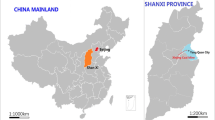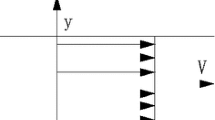Abstract
An underground investigation has been performed in a subbituminous coal seam exhibiting a particular cleat pattern in the Kushiro coalfield, Japan. The coal cleat pattern shows some analogy to isolated straight joints, and is believed to have been formed during the late Tertiary period by a compressive tectonic stress, roughly in the east–west direction. Three cylindrical coal specimens representing the three orthogonal axes of the coal seam with respect to the bedding plane and its associated cleat were cored from a large block of coal. Gas permeabilities of the three coal specimens were measured under the same hydrostatic pressure conditions. Results clearly revealed anisotropy in permeability of the coal seam under relatively low confining pressures of less than about 12 MPa. The specimen cored parallel to both the bedding plane and cleat strike showed the highest permeability, even though the cleats were partly filled with calcite and clay minerals. The permeability in this direction was 2.5 times higher than perpendicular to the bedding plane, and 3 times higher than in the direction parallel to the bedding plane but perpendicular to the cleat strike. This suggests that the cleats play a greater role than bedding planes in controlling fluid flow in the coal seam. The permeability in the three orientations, however, converged to the same value at confining pressures above about 16 MPa. This may suggest that both cleats and bedding planes in a coal seam can close due to earth pressure if the coal seam is located below a certain depth. It further indicates that the traditional view that gas permeability is always greater parallel to the coal bedding than perpendicular to it should be reconsidered.









Similar content being viewed by others
References
Alpern B (1970) Tectonics and gas deposit in coalfields: a bibliographical study and examples of application. Int J Rock Mech Min Sci 7:67–76
Beamish BB, Crosdale PJ (1998) Instantaneous outbursts in underground coal mines: an overview and association with coal type. Int J Coal Geol 35:27–55
Dumpleton S (1990) Outbursts in the South Wales coalfield: their occurrence in three dimensions and a method for identifying potential outburst zones. Min Eng 1990:322–329
Gamson D, Beamish D, Johnson D (1993) Coal microstructure and micropermeability and their effects on natural gas recovery. Fuel 72:87–99
Geological Survey of Japan (1967) Geological maps of the coalfields of Japan: explanatory text of the Kushiro coalfield. Hokkaido, pp 1–5 (in Japanese)
Harpalani S, Chen G (1997) Influence of gas production induced volumetric strain on permeability of coal. Geot Geol Eng 15:303–325
Harris I, Davies G, Gayer R, Williams K (1996) Enhanced methane desorption characteristics from South Wales anthracites affected by tectonically induced fracture sets. Coal methane and coal geology, Geological Society Special Publication No 109: 181–196
Hokao Z (1982) Prediction, method and countermeasure of gas outburst. Uchida Rokakuho, Tokyo (in Japanese)
Koide H (1998) The technology of CO2 sequestration. Environ Manage 34:750–754 (in Japanese)
Laubach SE, Marrett RA, Olson JE, Scott AR (1998) Characteristics and origins of coal cleat: a review. Int J Coal Geol 35:175–207
Li H, Ogawa Y, Shimada S (2003) Mechanism of methane flow through sheared coals and its role on methane recovery. Fuel 82:1271–1279
Omuta H, Mitsuda S (2002) The exploration of coalbed methane in the northern Bowen Basin, Australia. J Jpn Assoc Petrol Technol 67:72–82 (In Japanese)
Pattison C, Fielding C, Mcwatters R, Hamilton L (1996) Nature and origin of fractures in Permian coals from the Bowen Basin, Queensland, Australia. Coal methane and Coal Geology, Geological Society Special Publication No 109:133–150
Seidle J (1992) Application of matchstick geometry to stress-dependent permeability in coals. In: Proc Soc Petrol Eng. Rocky Mountain Regional Meeting, Casper, Wyoming, pp 433–455, SPE 24361
Su X, Feng Y, Chen J, Pan J (2001) The characteristics and origins of cleat in coal from Western North. China Int J Coal Geol 47:51–62
Xue Z, Ohsumi T (2004) Swelling in coal matrix caused by adsorption of carbon dioxide. Proc of 20th Energy System Symp Japan, Society of Energy and Resources, Osaka, pp 545–548 (in Japanese)
Acknowledgements
This research was financially supported by a grant-in-aid (14–02176) received by H. Li from the Japan Society for the Promotion of Science (JSPS). The fieldwork and sample collection were conducted by Dr. H Matsumoto and Y Ichihara at the Kushiro Coal Mine. This research benefited greatly from their support, which the authors gratefully acknowledge.
Author information
Authors and Affiliations
Corresponding author
Rights and permissions
About this article
Cite this article
Li, H., Shimada, S. & Zhang, M. Anisotropy of gas permeability associated with cleat pattern in a coal seam of the Kushiro coalfield in Japan. Env Geol 47, 45–50 (2004). https://doi.org/10.1007/s00254-004-1125-x
Received:
Accepted:
Published:
Issue Date:
DOI: https://doi.org/10.1007/s00254-004-1125-x




